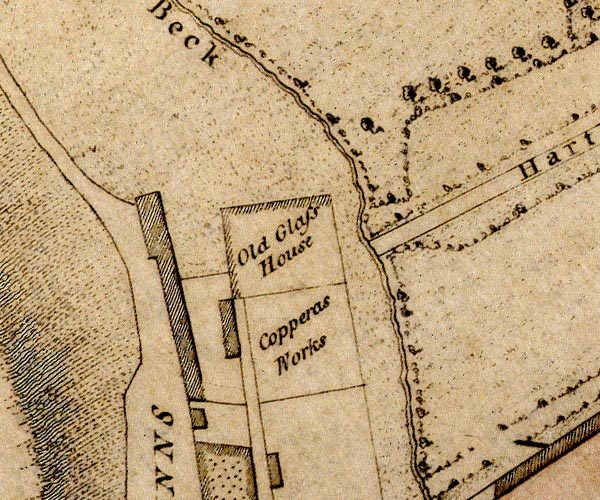 |
 |
   |
|
|
| locality:- |
Whitehaven (?) |
| civil parish:- |
Whitehaven (formerly Cumberland) (?) |
| county:- |
Cumbria |
| locality type:- |
copperas works |
| coordinates:- |
NX97371745 (guess) |
| 1Km square:- |
NX9717 |
| 10Km square:- |
NX91 |
| references:- |
Camden 1789
|
|
|
| evidence:- |
old map:- OS County Series (Cmd 67 6)
|
| source data:- |
Maps, County Series maps of Great Britain, scales 6 and 25
inches to 1 mile, published by the Ordnance Survey, Southampton,
Hampshire, from about 1863 to 1948.
"Old Chemical Works (Ruins)"
|
|
|
| evidence:- |
old map:- Donald 1774 (Cmd)
|
| source data:- |
Map, hand coloured engraving, 3x2 sheets, The County of Cumberland, scale about 1
inch to 1 mile, by Thomas Donald, engraved and published by Joseph Hodskinson, 29
Arundel Street, Strand, London, 1774.

D49717H.jpg
"Copperas Works"
building
item:- Carlisle Library : Map 2
Image © Carlisle Library |
|
|
| evidence:- |
old text:- Camden 1789 (Gough Additions)
item:- copperas
|
| source data:- |
Book, Britannia, or A Chorographical Description of the Flourishing Kingdoms of England,
Scotland, and Ireland, by William Camden, 1586, translated from the 1607 Latin edition
by Richard Gough, published London, 1789.
 goto source goto source
Page 181:- "..."
"[Sir John Clerk, in a letter to Mr. Roger Gale 1739] "The copperas works at Whitehaven
are a curiosity that deserves to be seen. The copperas is made by boiling the water
into a salt which comes from the brassy particles in sir James's coals gathered from
the rest of the coal when brought above ground, and sold at the same price. To this
they add pieces of rusty iron without any other ingredient.""
|
|
|
|
|
|
In the late 16th and early 17th centuries there was a great interest to produce at
home things which had hitherto been imports which were subject to the vagaries of
international relationships, and religious differences between goverments. Two such
items were Alum and Copperas, in greater demand by dyers because the home production
of coloured cloths was increasing. Alum was a mordant for dyeing, as well as having
uses by tanners, illuminators and painters. Copperas was a mordant, a black dye, and
was used to manufacture black ink.
|
|
James Blount, Lord Mountjoy, acquired a monopoly to work mines for alum and copperas
in southern England, confirmed by an Act of Parliament which made it clear that Elizabeth
I was anxious that the hidden riches of her realm should be found and put to good
use, saving imports of this verie necessarie commoditie for the use of Draperye.
|
|
|
notes:-
|
|
|
The mineral mined was iron pyrites, or just pyrites, iron sulphide, FeS2, a widely
occuring mineral.
|
|
Copperas is green vitriol or ferrous sulphate, FeSO4; in the old processes got from
iron pyrites by weathering to get a liquor - sulphuric acid? which was used to dissolve
any old iron. (Roughly!)
|
|
Celia Fienes, regarding Brownsea Island in the south of England:-
|
|
"... they gather the stones and place them on ground raised like beds in gardens, rows
one above the other, and are all shelving so that the raine disolves the stones and
it draines down into trenches and pipes made to receive and convey it to the house;
that is fitted with iron panns foursquare and of a pretty depth at least twelve yards
over, they place iron spikes in the panns full of branches and so as the liquor boyles
to a candy it hangs on those branches: I saw some taken up it look't like vast binches
of grapes, the cullour of the Copperace not being much differing, it lookes cleare
like sugar-candy, so when the water is boyled to a candy they take it out and replenish
the panns with more liquor; ... there are great furnaces under that keep all the panns
boyling; it was a large room or building with severall of these large panns; they
do add old iron and nailes to the Copperas Stones. ..."
|
|
|






 goto source
goto source